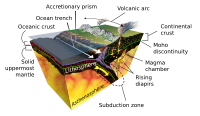
Photo from wikipedia
The physical and mechanical processes rooted in the hydrated, serpentinized mantle above subduction zones remain insufficiently explored despite fundamental implications for our understanding of rheology and fluid recycling along subduction… Click to show full abstract
The physical and mechanical processes rooted in the hydrated, serpentinized mantle above subduction zones remain insufficiently explored despite fundamental implications for our understanding of rheology and fluid recycling along subduction interfaces. Through a field‐based investigation, serpentinized peridotites and jadeitite samples from a fossil forearc mantle in the Polar Urals (Russia) are studied here to document fluid–rock interaction processes in the high‐P field, as well as the long‐term evolution of the base of the mantle wedge. Petrographic, geochemical and microstructural observations reveal a complex, protracted evolution of the jadeitite‐forming fluid pathway throughout the gradual cooling of the forearc mantle and increasing serpentinization of the host. It is shown that the jadeitite lenses in the studied locality (a) derive for a large part from a trondhjemitic dyke earlier emplaced in a warm subduction environment, and (b) record the cooling of the subduction hangingwall under high‐P conditions associated with increasing host serpentinization. In the studied locality, the majority of the jadeitites formed at relatively high temperatures (>600°C) by the influx of Na–Al‐rich, slab‐derived metamorphic fluids that were drained along the base of the mantle wedge, parallel to the subduction interface. Changes in bulk‐rock geochemical signatures and in paragenetic sequences also constrain the compositional evolution of the fluid channelized along this drainage, with an increasing sedimentary component. The phlogopite‐bearing walls of the dyke exhibit Rb–Sr and Ar–Ar ages ranging between c. 405 and c. 390 Ma, a range partly overlapping within uncertainty with the previously dated zircons from the jadeitite core (410–400 Ma; U–Pb). This study opens a unique window on the pristine structures formed above the plate interface by melting and fluid–rock interaction in the early subduction stages, as well as their evolution during secular cooling of the base of the mantle wedge.
Journal Title: Journal of Metamorphic Geology
Year Published: 2020
Link to full text (if available)
Share on Social Media: Sign Up to like & get
recommendations!